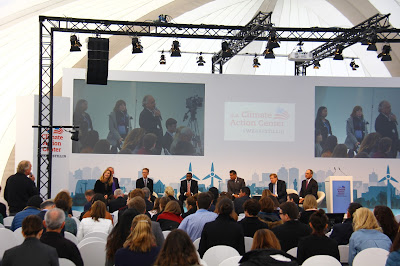Ambition at COP23
Posted by: Anna McGinn
At this COP, we are talking a lot about ambition.
In Will’s most recent post, he explains the Global Stocktake which is one major element of how countries plan to institutionalize and then operationalize increasing ambition on climate action. The World Resources Institute worked with the UNFCCC to create "the arc of ambition" (image below) to chart the path towards net-zero emissions and climate resilience by 2050. You can see the global stocktakes prominently featured within this arc.
So, this arc looks like the UNFCCC and its parties have everything under control, right? So, why is there so much to talk about on ambition here at COP23 outside of this planning for the global stocktake?
To understand this, we have to go back to 2015 when the countries were negotiating the Paris Agreement. Since they did not know when the Agreement would enter into force during the negotiations (because they agreed that it would enter into force whenever at least 55 countries representing more than 55% of global greenhouse gas emissions ratified the Agreement), many plans were embedded into the Agreement to kick into gear in 2020.
Fast forwarding a year, the Paris Agreement received the required ratification in unprecedented time, and the Agreement entered into force in early November 2016 before COP22. This caused a scramble to prepare for the first meeting under the Paris Agreement which took place during COP22 because it was just so unexpected that countries would take action to ratify so quickly.
All this being said, now countries have a number of years between entry into force (November 2016) and 2020 which is the date for most of the actions committed to within the Paris Agreement. This is one major topic of discussion here in Bonn. Many of the developing countries and especially the Small Island States say that it is not good enough to just write the rules of the Paris Agreement until 2020 and then start action then. They call for action and increasing ambition to start now. Conversely, some of the developed countries say that it is imperative that the processes and modalities are in place and this should be the focus between today and 2020. Thus is born the campaign for pre-2020 ambition.
This was started last year in Marrakech, and has continued in a strong way here in Bonn. Last week, developing countries demanded that the Fiji presidency bring conversations on pre-2020 to the forefront, and an additional steam of negotiations was initiated to address this topic.
During the day to day negotiations that I am attending, the focus is still very much on establishing how the Paris Agreement is going to work--these take place under the Ad hoc Working Group of the Paris Agreement. But countries, often representing the G77+China and the Least Developed Countries Group (LDCs), make interventions to highlight the urgency of taking action sooner with the hope of moving the conversations forward more quickly.
Pre-2020 ambition is likely to be the rallying call of countries facing impacts of climate change without the domestic financial capacity to deal with these impacts. And this pre-2020 ambition is not only needed on the mitigation side, but also on the adaptation and finance elements of the UNFCCC work. By the end of the COP, we should have a better idea of the extent to which countries decide to commit to action in 2018 and 2019.




Comments
Post a Comment